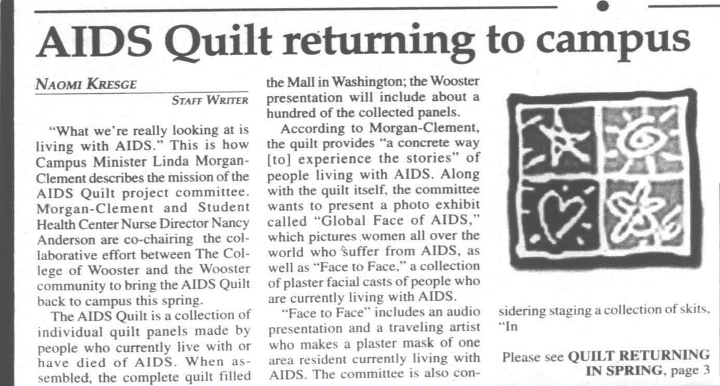Case File: HIV/AIDS Part 2
- Home
- Long-Term Diseases
- Pandemic!
- Special Exhibitions
- Case File: HIV/AIDS Part 2

The impact of the HIV/AIDS crisis on the College of Wooster campus would grow to become an opportunity for the campus to improve itself, particularly in the areas relating to those who were HIV positive. This would continue to grow throughout the 1990s. The AIDS crisis. had long been used to discriminate against the LGBT+ community. However in the 90s, the crisis would foster a new conversation of LGBT+ rights leading to increased inclusion on campus.[i]
The AIDS crisis would eventually see the entrance of another important part in this period of campus history: the Names Project Aids Memorial Quilt. This quilt, which has been brought to Wooster a total of 5 times, is a visual representation of all the lives that were lost to the virus. The campus, working together with a group of volunteers from the town to form the AIDS Quilt project Committee, was able to use the quilt to bring awareness to the tragedies of the AIDS crisis and all the lives that had been lost.[ii] If there had not been volunteers and members of the Wooster community so dedicated to bringing a range of personal stories and panels to the community through the quilt, it is doubtful that the quilt would have been as impactful as it was.

“Through education and activism, we have fought against the ignorance and prejudice that so often characterized the response to the epidemic,” reads a 1996 quote from The Wooster Voice.[iii] The movement of support for those who were diagnosed as HIV positive or had lost a loved one to the virus would eventually result in a policy change for the campus. This policy protected those who were diagnosed with AIDS and would eventually grow to include any individual who identified as LGBT+.[iv] The previously unheard voices from the past several decades would finally be visible and allow a far greater inclusive environment to blossom on the campus. What started as a crisis of loss and stigmatization would open up a conversation that continues to shape the world today.
[i] Peter T. Stratton, “Reflections,” The Wooster Voice (Ohio), October 19th, 1990
[ii] Naomi Kresge, ”AIDS Quilt returning to campus,” The Wooster Voice (Wooster), September 9, 1999
[iii] Sohil N. Parekh, ”AIDS Quilt Comes to Wooster,” The Wooster Voice (Wooster), April 19, 1996
[iv] Todd Lewis, ”AIDS topic continues FYS,” The Wooster Voice” (Wooster), October 29, 1993
Header image: “HIV Infected T-Cell.” The National Institute of Allergy and Infectious Disease. Accessed July 1, 2020. Online at Flickr.
Figure 2: “AIDS Quilt.” The National Institute of Health. Accessed July 1, 2020. Online at Wikipedia.

